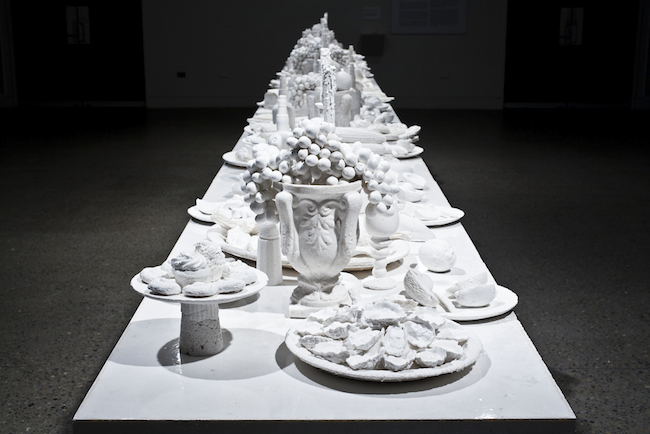Artists Ken and Julia Yonetani produce sculptural works that often speak to current issues involving the rocky relationship human beings have with the environment.
Above image: Ken and Julia Yonetani, The Last Supper, 2014, Murray River Salt, 9 x .72 x 1.22 meters
The pair describes their work in their bio:
“Ken + Julia Yonetani’s work explores the interaction between humans, nature, science and the spiritual realm in the contemporary age, unearthing and visualizing hidden connections between people and their environment. Their installations work within an interdisciplinary field, inspiring responses through all five senses – sight, smell, taste, hearing and touch. They incorporate performance and prompt the viewer through immersive interaction at the most basic of levels. The connection between audience and environment is undeviating within a powerful aesthetic. Their work is highly accessible, attracting international acclaim and widespread attention for its combination of aesthetics and nuanced expression of contemporary issues.”
Their work includes some strange materials for sculpture; the materials themselves being a comment on the subject of the work. The pair created a series of sculptures using uranium glass following the Fukashima Nuclear Power Plant disaster, for example. We’re profiling a one of their works that involves salt.


In The Last Supper, the artists used one ton of salt collected from the Murray River in Australia to create a nine meter long table set with food. It is a banquet, but the salt coupled with the title conceals a troubling message. From the artists:
“…The work points to concerns arising from increasing salinity levels in Australia and unsustainable agricultural practices. In the aftermath of the Fukushima disaster, the massive banquet of luxurious foodstuffs also becomes a larger visualisation of the problems of food security and safety in an increasingly toxic world.
“The salt used in the work is a small portion of the 550 tonnes of groundwater salt from the Murray Darling basin that is pumped out of the ground each year to try and stem the increasing rise of highly saline groundwater in an area that produces up to ninety per cent of Australia’s domestically grown fresh food.”
The title refers to da Vinci’s The Last Supper. In addition to the grim foreshadowing that association creates, there’s also a link to salt between the two works. Judas, in da Vinci’s painting, can be seen knocking over a saltshaker. In the same year, the artists showed The Last Suppermarket, which used river salt in a makeshift supermarket. The former work was commissioned by Hazelhurst Regional Gallery and Artes Centre and the latter was a part of the Fehily Contemporary stand at the Melbourne Art Fair.
The duo describes salt as “both beautiful and disconcerting,” a material that gives the viewer an immediate sense of connection to the earth, but also which appears ethereal and creates unease about what the future could hold. You can watch Ken and Julia talk about the material in the videos below.
The second project seems tame by comparison, but its materials still evoke that connection viewers have with the Earth. Breathing Tree (2012) uses manganese-glazed ceramics to create a kind of scientific diagram of a leaf in the facade of a the Blue Mountain Cultural Centre in New South Wales, Australia. About 14,000 ceramic pieces take on the look of stomata, pore openings that leaves use in photosynthesis and respiration (think back to your elementary school science class, you’ve seen these diagrams before.)
The work was a collaboration with Dr. Ian Kaplin and utilized electron microscopes from the Australian Microscopy and Microanalysis Research Facility in the University of Sydney. Cloudscape, a blog for the Blue Mountains Design Bureau ran a brief interview with the pair in light of the project; it can be read here, although the questions do not probe deeply into their work.
Any thoughts about this post, share yours in the comment box below.

Ken and Julia Yonetani, Breathing Tree, 2012







Add your valued opinion to this post.